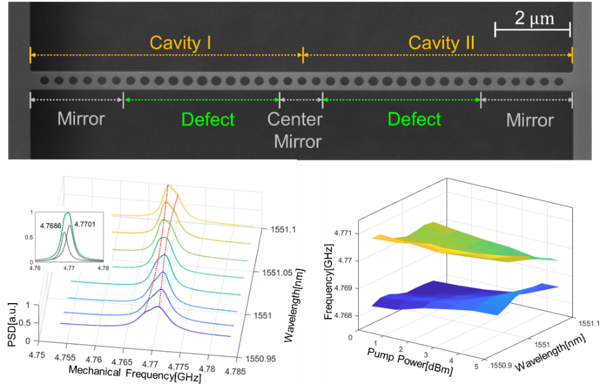Tunable coupled mechanical resonators have attracted considerable attention in quantum simulations, quantum computations, and non-Hermitian physics. In particular, the tunable coupled mechanical resonators with high mechanical frequency have great potential for realizing high-sensitive exceptional points sensors with increased resistance to environmental disturbances and sensing bandwidth.
Moreover, the realization of coupled mechanical resonators with both high frequency and large tunability can be used to study physical effects such as parity-time symmetry, non-reciprocal transmission, and topological energy conversion in non-Hermitian systems.However, the tunable coupled mechanical oscillators have been mainly studied based on low-frequency vibration modes at MHz frequency so far.
In order to realize the coupled mechanical resonators with both high frequency and large tunability, the associate Prof. Kaiyu Cui and the Ph.D candidate Qiancheng Xu, etc, from Nano-Optoelectronics Laboratory, the research group led by Prof. Yidong Huang, at Department of Electronics Engineering, Tsinghua University, reported tunable mechanical-mode coupling at GHz frequency. The relevant research results are published in Photonics Research Volume 10, No. 8, 2022 (Qiancheng Xu, Kaiyu Cui, Ning Wu, Xue Feng, Fang Liu, Wei Zhang, Yidong Huang. Tunable Mechanical-Mode Coupling Based on Nanobeam-Double Optomechanical Cavities. Photonics Research, 2022, 10(8): 1819).
In this study, the authors propose the manipulation of mechanical mode coupling beyond GHz range based on nanobeam-double optomechanical cavities by using optical spring and optical gain effects, as shown in Fig 1. The optical spring effect was used to change the mechanical-mode frequency to realize mode degeneracy of two mechanical resonators.
Furthermore, the optical gain effect was exploited to manipulate mechanical coupling by adjusting mechanical loss. The influence of the mechanical coupling interaction was analyzed using coupled-mode theory. In experiments, mechanical-mode coupling between two mechanical supermodes of the proposed structure with a frequency of 4.96 GHz was realized through asymmetric tapered fiber coupling. The frequency difference of the two mechanical supermodes can be dynamically controlled by changing the power and wavelength of the pump laser in Fig 1. In addition, the influence of the thermal-optic self-pulsing effect on the tuning range of coupling was observed and discussed.

Fig. 1 Schematic of the nanobeam-double optomechanical cavities and optical control of the two mechanical-mode couplings: the normalized mechanical power spectrum density for various pump wavelengths, and the non-Hermitian parameter space diagram of mechanical-mode coupling with pump power and pump wavelength.
For the parity-time symmetry architecture used in this study, it will provide a guideline for achieving microscopic mechanical parity-time symmetry to realize topology and high-sensitivity sensors chips. What is more, the long-range tunable optomechanical system might be realized in the future based on the mechanical-connection nanobeam structure of the double optomechanical cavities which can offer long-range mechanical interaction.


